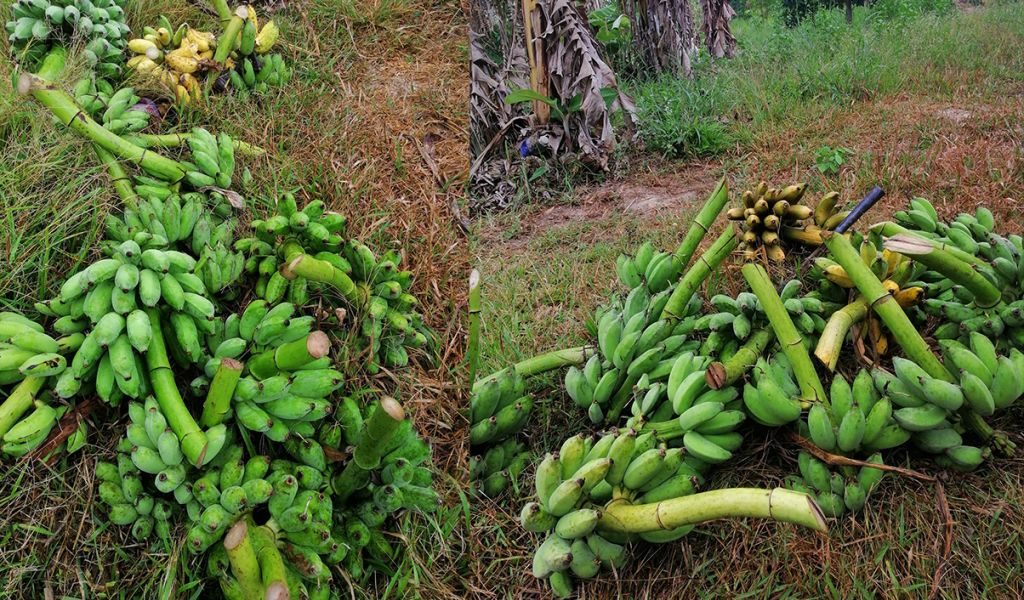ກ້ວຍນ້ຳ / Kluai Nam Wa
APA 6th ed. ກ້ວຍນ້ຳ / Kluai Nam Wa. (2020, December 8). Retrieved from https://www.phakhaolao.la/kb/0000362
MLA 8th ed. ກ້ວຍນ້ຳ / Kluai Nam Wa. Pha Khao Lao, 8 December 2020, https://www.phakhaolao.la/kb/0000362.
Chicago 17th ed. Pha Khao Lao. 2020. "ກ້ວຍນ້ຳ / Kluai Nam Wa." Published December 8, 2020. https://www.phakhaolao.la/kb/0000362.

Musa × sapientum var. angao Quisumb.
Musa × sapientum var. baca Quisumb.
Musa × sapientum var. binutig N.G.Teodoro
Musa × sapientum var. canara N.G.Teodoro
Musa × sapientum var. canaya Quisumb.
Musa × sapientum var. champa (Baker) Baker
Musa × sapientum var. cinerea (Blanco) N.G.Teodoro
Musa × sapientum var. compressa (Blanco) N.G.Teodoro
Musa × sapientum var. cubensis N.G.Teodoro
Musa × sapientum var. dacca (Horan.) Baker
ໄທ: ກ້ວຍນ້ຳຫວ່າ
Kluai Nam Wa is one of the most commonly grown banana cultivars in Laos. It is a cross between Musa acuminata and M. balbisiana and belongs to the ABB genome group. The plant is a large, leafy, monocotyledonous, clump-forming herbaceous perennial, 3–4 m tall. Leafy shoots emerge from underground rhizomes. What appears to be a “trunk” is in fact a pseudostem made up of closely furled, tubular sheaths. Leaf blades are oblong, green, waxy, smooth, and up to 1 m long. When the plant is mature, the inflorescence emerges from the top of the pseudostem and consists of many bracts covering rows of flowers. Fruit develop from female flowers in a large hanging tiered cluster called a bunch. After fruiting, the pseudostem dies back. Cultivated bananas are almost always seedless.
Food: Nam wa bananas have many uses and are widely grown. When ripe, the fruits are eaten either raw or cooked; unripe green fruit can be processed into flour. The skin is relatively thin and the flesh is sweet. Nam wa bananas can be mashed and used as baby food or dried and made into snacks, such as banana chips. The flowers are eaten as a vegetable. The leaves are commonly used as plates or for wrapping round rice, fish, or meat while cooking.
Medicinal:
– Constipation: Banana consumption is effective in curing chronic constipation. Because the fruit contains pectin, which is a soluble fiber, it helps to stimulate the bowels, improving the passage of the stool.
– Diarrhea: Raw bananas can be eaten to relieve diarrhea. They contain tannin, an astringent substance that inhibits the growth of germs. Too much tannin may damage the lining of the stomach, however.
– Fatigue: Bananas are a source of instant energy and can be eaten to combat tiredness. They also contain many vitamins. In China, bananas are commonly steamed, cooked, dried, ground into powder, or used as a tonic.
– Menstrual pain: Banana flowers, sometimes in the form of a tea, are a popular remedy for period cramps.
– Toothache: The roots can be used to alleviate toothache. Take a handful of banana root, clean it, then boil in water for 15 minutes. Add salt to taste. Leave to cool. Drink whenever toothache is felt.
– Bad breath: Eat a ripe banana after waking in the morning, then brush your teeth. If this is done regularly the bad breath will abate.
– Skin disorders: For flaky skin or a red rash rub the affected skin with banana peel frequently. Over time, the condition will disappear.
– Acid stomach: Crushed ash from burnt banana leaves can be used to brew a tea that is good for heartburn or acid reflux. One teaspoon per day is taken after meals. Bananas are alkaline and also help to reduce stomach acid.
– Sprains: A soft banana leaf applied to a sprain relieves the pain and aids healing.
– Skin condition: Eating a banana three times a day helps to keep the skin hydrated and soft.
– Bleeding: Banana stems can be used to stop bleeding. Banana shoot tips applied to a wound will stop blood flow, but will give a burning sensation.
– Snake bite: Bananas are traditionally used to neutralize the poison following snake bite. They are said to reduce pain and swelling.
Culture and everyday life:
Conical offerings constructed from banana leaves are central to many religious ceremonies in Laos, such as Buddhist festivals and blessings. A baci is an important spiritual ceremony in Lao culture held to mark many different events throughout the year, including births, deaths, weddings, welcoming guests, house warmings, monk-making, new year, and prior to traveling. Banana leaf and marigold flower offerings are always present. For example, a newborn child is welcomed with a baci ceremony one month and a day after the birth. A wedding ceremony often has banana and sugarcane decorations in the procession and the feast will include bananas and banana snacks.
In house building, when there is a ceremony to raise the pillar, banana shoots are bound to the end of the pillar together with a sugarcane. When the house is finished, a house-warming party is held and banana trees and sugar canes are planted around the house so that after about a year, there are bananas to eat. Traditionally, banana leaves are used in funeral rites. In everyday life, banana leaves are used to wrap food to keep it fresh. Food is also wrapped in parcels before steaming or boiling. Many savory and sweet dishes, such as steamed rice, fish and desserts, are cooked by wrapping the ingredients in banana leaves and then steaming. This method of cooking allows the foods to absorb the flavor of the banana leaves and keeps the food moist. Sun-dried banana leaves are also used.
